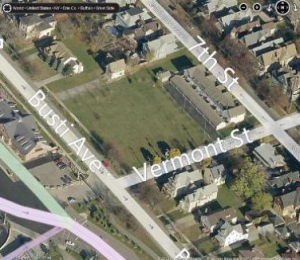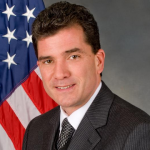Nov 13
2013
A smell surrounding Peace Bridge air study
State officials proclaimed a month ago that air monitoring results near the Peace Bridge showed no serious pollution problem in the adjacent neighborhood plagued by high asthma rates that studies have linked to bridge traffic.
In fact, officials went so far as to declare: “the data suggest that there are no significant differences between air quality in the plaza neighborhood and in the City of Buffalo overall.”
However, an Investigative Post analysis has determined that conclusion is “not scientifically valid,” in the words of Sherri Mason, associate professor of chemistry at SUNY Fredonia, one of nine experts interviewed for this story.
Officials are correct in saying air quality near the Peace Bridge meets federal standards. But what they didn’t say is the air ranks among the dirtiest in Western New York, with pollution levels comparable to those recorded at monitoring stations near chemical plants in Niagara Falls and one of the busiest stretches of highway in the region in Buffalo.
“I certainly would not reach a conclusion saying that the air is safe,” said Judith Enck, regional administrator for the Environmental Protection Agency.
Read the DEC’s Peace Bridge Air Monitoring Study Here
DEC officials conceded, after more than a week of questioning by Investigative Post, that their conclusion that air quality near the Peace Bridge was comparable with the rest of the city was “a mistake.”
But Investigative Post found that’s not the only problem with the DEC’s testing.
The air monitoring last six months, through March of this year, skipped the summer months when bridge traffic is a third higher. Experts disagree as to whether including those months would have significantly changed the study’s outcome. But past studies found that the pollutants that the DEC tested for almost doubled in the summer.
Secondly, experts said the testing wasn’t comprehensive enough to provide a full picture of air pollution that can impact the community’s health.
“Any conclusion that air quality at the Peace Bridge and on the Lower West Side is no worse than the general urban environment and not creating any additional health problems beyond the usual urban levels is at best totally premature and based on woefully incomplete data,” said William Scheider, a research assistant professor in environmental health for University at Buffalo.
Contradicting past studies
A series of independent studies conducted from 2000 to 2006 established a link between pollution from bridge traffic, especially diesel fumes from trucks, and respiratory illnesses among neighborhood residents.
Perhaps most telling was a 2002 study that found asthma rates among neighborhood residents were nearly four times the national average. The neighborhood near the bridge is two-thirds minority and almost half of the population lives below the poverty line.
A study by the Health Effects Institute in 2005-06 used stationary and mobile air monitors that tested for more than 100 chemicals, far more comprehensive than the DEC’s monitoring campaign that measured only two types of pollutants.
The DEC agreed last year to test the air because of pollution concerns expressed by neighbors and two community organizations, the Clean Air Coalition of Western New York and the Niagara Gateway Columbus Park Association. Those fears have been heightened by the governor’s push to expand the bridge plaza and reroute traffic leading to and from the bridge.
The DEC placed one stationary monitor downwind of bridge traffic on a vacant lot at the corner of Vermont Street and Busti Avenue, behind the duty free store at the entrance to the bridge. A second monitor was upwind of the traffic overlooking the Thruway at the southwest corner of Front Park.
DEC officials compared the data collected at these two monitoring stations with the results from permanent monitors on Dingens Street in Buffalo and Niagara Falls.
The Dingens Street monitor is near the Buffalo-West Seneca border where the downtown section of the Thruway merges onto the I-90 headed to Albany and Erie. The DEC considers this location to be the city’s most polluted area because of its proximity to the Thruway, said Dirk Felton, author of the report for the DEC’s Bureau of Air Quality Surveillance. Up to 75,000 vehicles a day pass the monitor.
The Niagara Falls monitor is at the intersection of Frontier Avenue and 55th Street, which is sandwiched between homes and chemical plants such as Occidental Chemical, Niacet, DuPont and Praxair.
The results showed almost identical levels of air pollution at all four locations.
From that, the DEC press release concluded that air quality at the bridge is “consistent with levels in the city overall.” But no monitoring happens in other city neighborhoods.
“The press release misrepresents the situation regarding air pollution around the bridge compared to the rest of the city,” said Scheider of UB.
An appendix in the DEC’s air monitoring report essentially dismissed the findings of the Health Effects Institute, pointing to technological advances since the studies were published. Those advances include low-sulfur diesel and truck filters that have reduced by as much as 95 percent the airborne pollutants trucks emit.
Enck of the EPA suggested a different approach. She said the government needs to do a better job of working with the community to reduce pollution.
“I think getting into dueling studies is not particularly helpful in making blanket statements that this air is no worse than anywhere else,” she said. “It probably does not reassure the public who has concerns about air quality.”
Testing skipped summer months
The DEC monitored air quality from Aug. 31, 2012, to March 17 of this year. In doing so, it failed to track pollution during the peak travel months that produce the most congestion and pollution.
How much traffic did the monitoring miss?
As many as 8,000 vehicles a day, depending on the month.
The testing skipped the summer months, when bridge traffic is one-third heavier than in the dead of winter.
Put another way, traffic averaged 21,662 vehicles a day in August 2012 vs. 13,795 this past February.
In addition, trucks were routed through the neighborhood this summer at least 15 times because of congestion, said Ron Rienas, general manager for the Peace Bridge, at an Oct. 7 environmental conference.
The DEC monitoring missed all of this.
Mason, the Fredonia professor, said the DEC is providing the best-case scenario of air pollution at the bridge by testing during months with the least amount of traffic and congestion.
“They really should’ve been looking at the absolute busiest time of the year, especially considering the community … already shows that they are susceptible to these kind of air pollution concerns,” Mason said.
Jack R. Harkema, the director of one of four clean air research centers in the country at Michigan State University, agrees. Harkema is also one of seven members on the Clean Air Scientific Advisory Committee that every five years makes recommendations to the Environmental Protection Agency on air quality standards.
“Definitely that is a problem,” Harkema said about the DEC not testing during months with the most traffic. “The likelihood is that those levels would be higher.”
Steve Flint, the DEC’s assistant director of the division of air, said the agency didn’t have the resources to continue monitoring through the summer because that is his department’s busiest time of the year.
Even if they did test during the busy summer months, Felton assumed the results wouldn’t have changed much.
“I don’t know we would’ve gotten a much different result,” he said. “Perhaps it would have been ever so slightly higher on average if we had been there in the summer when the backups were a little bit longer.”
On the contrary, the Health Effects Institute’s study found the pollution level for the contaminants tested by the DEC was 45 percent higher in the summer of July 2005.
Even worse, the HEI study found concentrations for many other chemicals were higher in the summer — in some cases, three to five times higher because of more traffic and lake wind conditions.
The Clean Air Act requires that the air quality standards are developed in a way that protects public health “with an adequate margin of safety,” including susceptible populations.
Harkema said numerous studies have found that health problems increase the closer residents live to busy roadways. What’s more, newer studies show pollution levels deemed acceptable under federal standards can still cause problems for susceptible populations.
“There is more and more out there that is saying that if you are close to a power plant or close to a roadway you have higher exposures, and oftentimes people who live close to these areas are the most socioeconomically deprived,” Harkema said.
What DEC didn’t test for
Experts said the testing was not comprehensive.
For example, the HEI monitoring in 2005-06 tested for more than 100 chemicals, including ones directly associated with vehicle emissions, such as benzene, toluene and xylenes. HEI researchers also measured for what’s called “ultrafine particles.”
Ultrafine particles are a thousand times smaller than the pollutants the DEC tested. They are inhaled deeper into the lungs, can enter the bloodstream and spread toxins faster, said Jamson Lwebuga-Mukasa, a pulmonologist and epidemiologist who worked on the HEI study.
The DEC should have tested for these particles, Mukasa said.
“When you breathe these particles in they can cause irritation of the airways and it’s the irritation of the airways that causes the asthma,” Mukasa said.
Felton said the DEC did not test for these particles because the federal government has not established a standard for what constitutes an unhealthy level.
“What would we compare the numbers to?” Felton said.
“The Health Effects Institute said ultrafine particles were higher, but that was the end of the story. They didn’t have anywhere to go with the information.”
‘Just an accident’
Constantakes, the DEC spokesman, shouldered the blame for the misstatement in the press release that said the study showed air quality near the bridge is similar to all other parts of the city. He said the statement was reviewed by the governor’s press office before it was released.
“It was just an accident made by myself as a press officer,” Constantakes said.
Elsewhere in the press release, Sen. Mark Grisanti said: “I am pleased that air testing has shown no significant air quality concerns in communities near the Peace Bridge Plaza.”
Grisanti, chairman of Senate’s Environmental Conservation Committee, said in an interview he did not read the full report before issuing his statement.
“What I’m saying is what was in the executive summary on the issues that were actually tested meet the federal guidelines,” he said.
Grisanti said state officials are not ignoring the health concerns of the neighborhood.
“Absolutely not,” he said. “We’re actually facing the problem head on.”
Scheider sees it otherwise.
“The powers that be … are playing dice with the health of thousands of residents on Buffalo’s Lower West Side,” he said.
Read Investigative Post’s transparency policy on Peace Bridge related stories.


